
Convicts should be trained to push wheelchairs safely to help cope with the growing number of elderly prisoners, according to new proposals.
Lags should also learn how to help fellow inmates who are too frail to clean their own cells as well as delivering washing and food, according to a new report.
The Scottish Prison Service-commissioned review comes after the number of pensioners dubbed “Saga louts” behind bars has nearly doubled in just over a decade.
It urges jail bosses to consider training hardened criminals to earn care qualifications creating a legion of elderly care “champions”.
The report says prisons should look into developing “prisoner responsibilities for assisting peers with high care needs who require assistance with daily living activities”.
These include “pushing wheelchairs, cleaning and tidying cells and assisting with the delivery of food”.
There were 746 inmates over the age of 50 in jails in 2014 a 93% increase on 2001.
The rise has been put down to people living longer and a surge in the number of ‘historic’ sex allegations being reported in the wake of the Jimmy Savile scandal.
Among the proposals put forward by Dundee-based consultants Figure 8 are plans to create care-home style facilities for elderly lags.
Councils are currently responsible for care in the community, although the report warns it is “presently unclear” who is responsible for prisoners. It reveals one prison, Glenochil in Clackmannanshire, has had to bring in a private company to provide taxpayer-funded care for one of its inmates.
The authors of the report are now calling for an understanding between the SPS, NHS Scotland and councils to decide who is responsible for the care of elderly prisoners. They also looked at whether Scotland’s prisons were fit for elderly and disabled prisoners even suggesting refurbishing a prison specifically for elderly lags.
Some prisons in England have already made changes, including building allotments and installing stair lifts and more benches.
A paper published last year by Dr Sarah Couper, specialist registrar in public health medicine at NHS Forth Valley, and Dr Andrew Fraser, director of public health science at NHS Health Scotland, said that “options now need to be debated” for providing care for “frail prisoners”.
It went on: “The physical infrastructure of some prisons creates access problems for some prisoners. Stairs and walking are two of the most common problems.”
Jail chiefs are now considering the recommendations as a way of dealing with the problem of pensioner inmates.
An SPS spokeswoman said: “The findings will enable SPS to consider how best to respond to the future management of prisoners with high care needs.”
Among Scotland’s notorious older convicts is Peter Tobin, 68.
He is serving a life sentence in Saughton Prison in Edinburgh for the murder of three young women Angelika Kluk, Vicky Hamilton and Dinah McNicol.
Britain’s oldest prisoner is Gaston Pinsard, 96, who got 18 months for indecently assaulting two girls aged between five and nine.
A court heard Pinsard felt like a “filthy devil” who could not control his sexual urges when he attacked the youngsters at his home in the 1950s and ’60s.

Enjoy the convenience of having The Sunday Post delivered as a digital ePaper straight to your smartphone, tablet or computer.
Subscribe for only £5.49 a month and enjoy all the benefits of the printed paper as a digital replica.
Subscribe